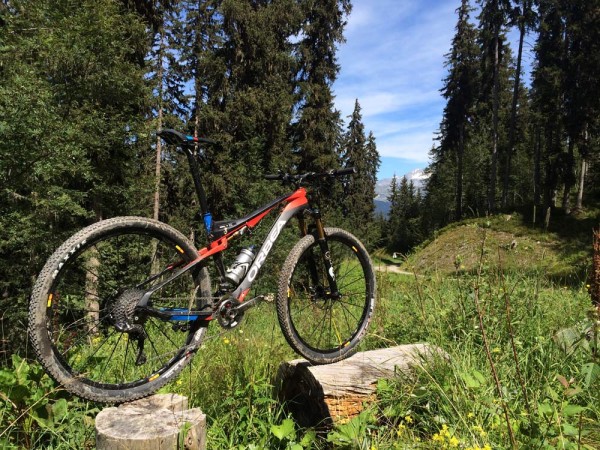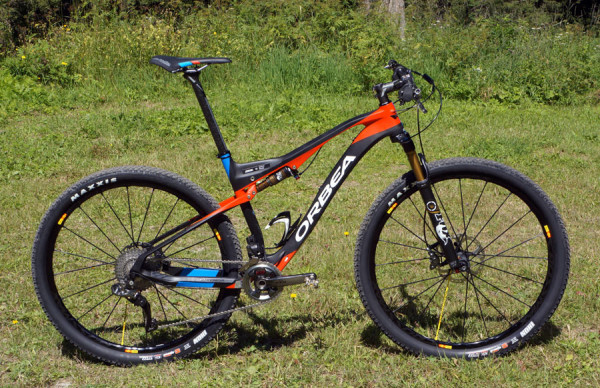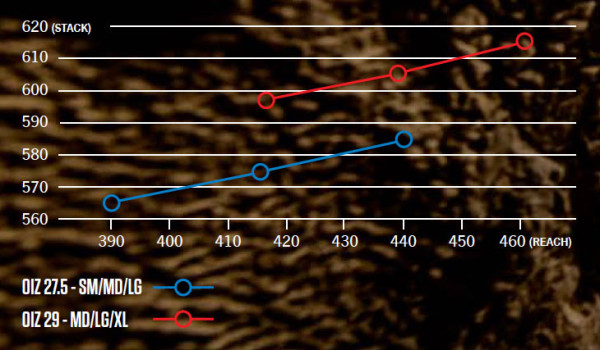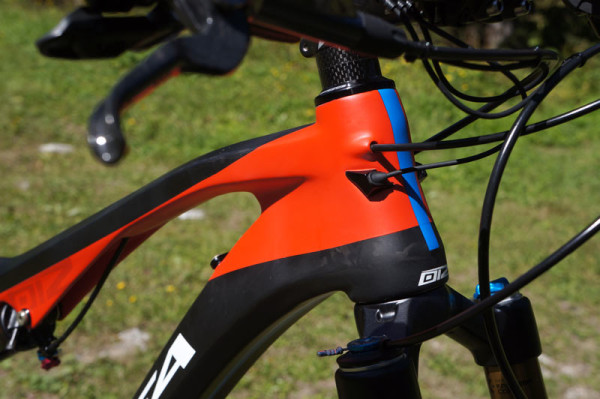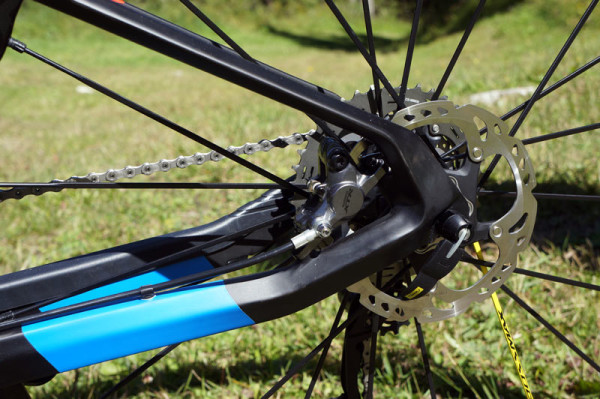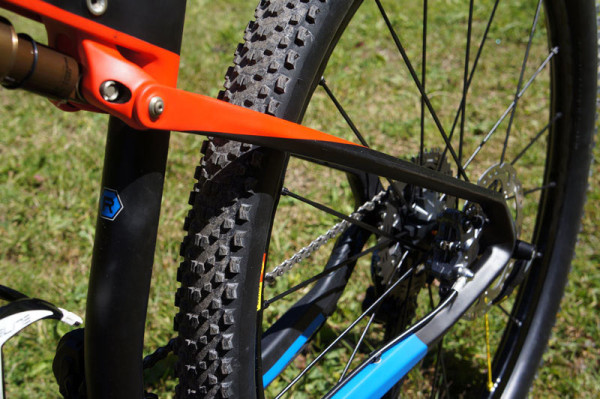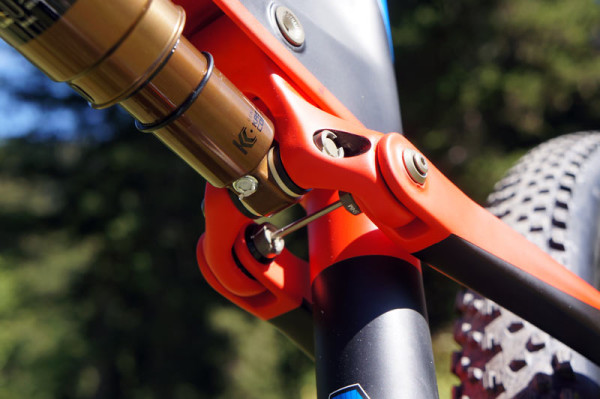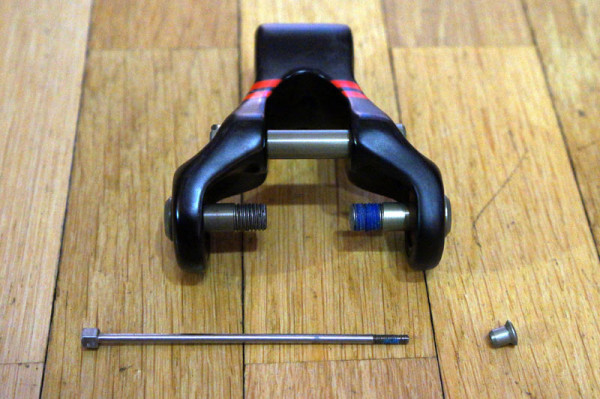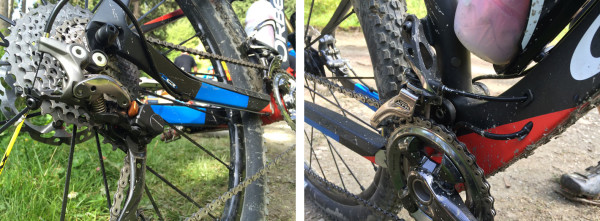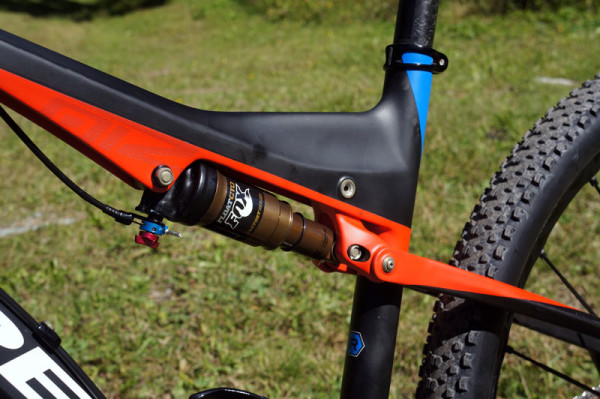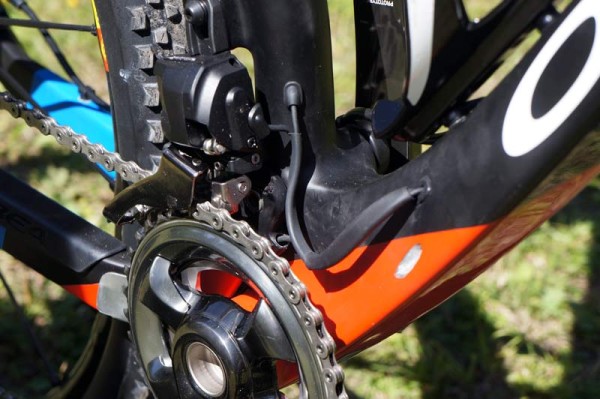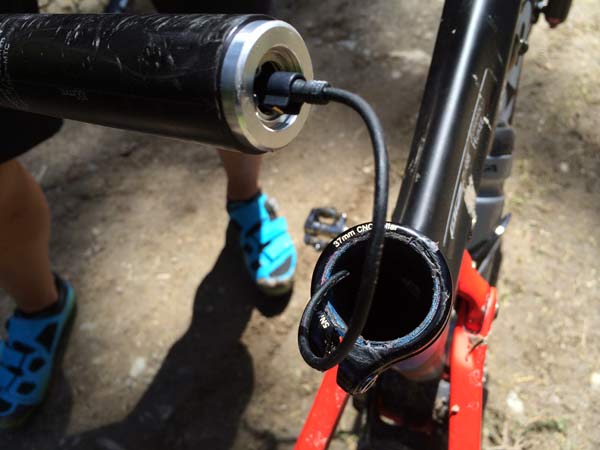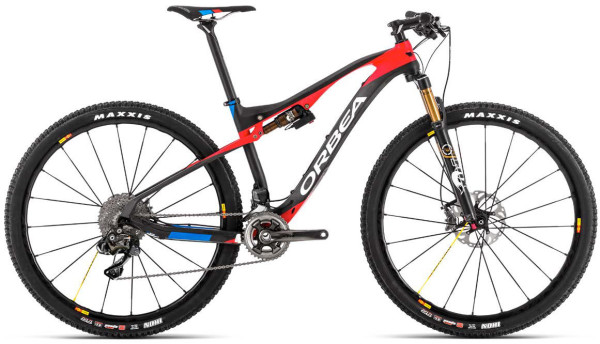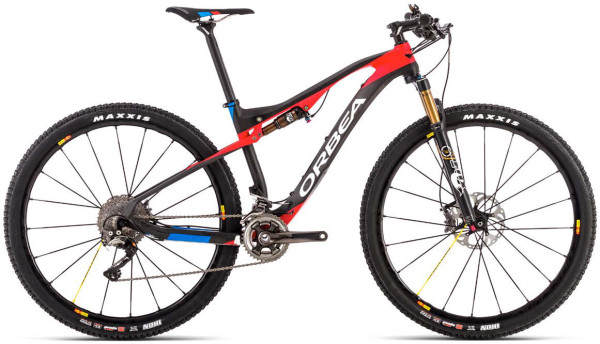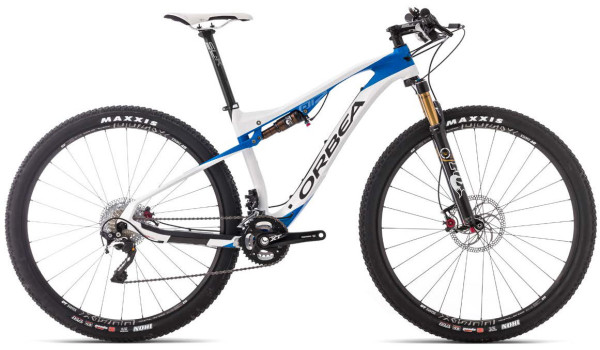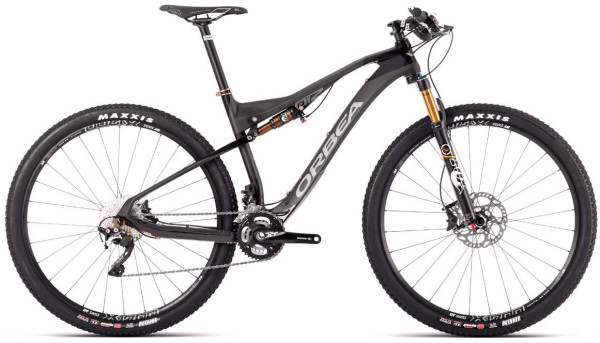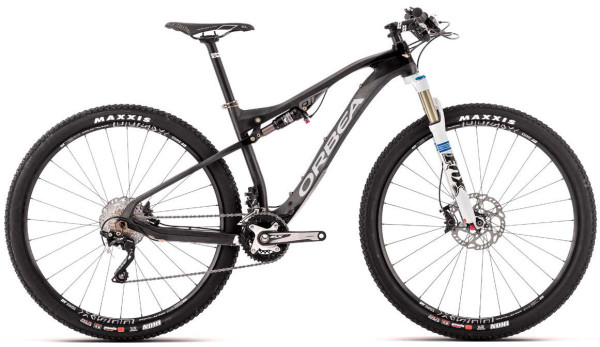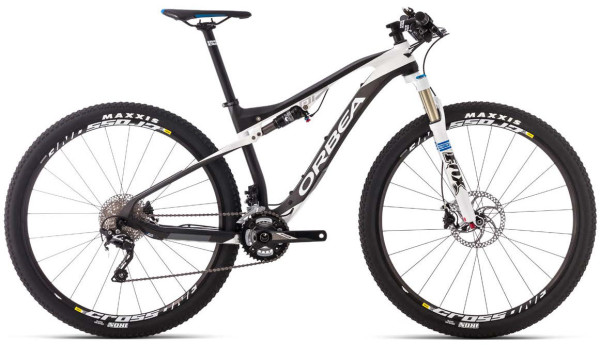The Orbea Oiz first appeared under the Luna Chix pros as a 26” full suspension race rocket in 2012. From the beginning, it was made to be as efficient as possible, very light weight and just plain fast. In other words, to win races. World Cup races, to be exact. And it did, taking the podium top at Mont Saint Anne under Catherine Pendrel. And then she repeated a week later at Wyndham.
Even then, though, the cross country market was leaning heavily toward 29ers. Now it’s all but swung that way entirely, save for a slight intrusion of today’s hot wheel size, 27.5”, relegating 26” bikes to the entry level market, not the World Cup race level. So, the Oiz has been updated, taking advantage of Orbea’s BWC (Big Wheels Concept) to offer both wheel sizes. The 27.5” (650B) wheels will come on S/M/L size frames, and 29er will be on M/L/XL.
Beyond the wheels, the spirit of the bike has remained the same, but it does get retuned and tweaked to make the most of the new wheel sizes. That means it keeps the 95mm rear wheel travel, a number that was intentionally kept under 100mm so there was no confusion as to this bike’s purpose. You won’t be tempted to put anything more than a 100mm fork on it…
Offering two wheel sizes was all about fit. When 29ers took over the race scene, the stack height went way up, leading many people run negative rise stems or end up with higher bottom brackets and/or shorter travel forks to compensate on the smaller frame sizes. None of those solutions are perfect, particularly the last two since they compromise the sharp handling and performance a top level XC race bike needs. Orbea’s solution was to offer 27.5” wheels on the smaller sizes, which opened up better fit options for smaller riders or those with challenging body proportions, but still gave the bike the benefits of larger wheels. All of their measurements are based on a progressing stack and reach:
Stack is how high your handlebar is from BB center, and reach is how far out in front of BB center the handlebar is. The Oiz’s stack is among the lowest available on any bike, and is lower on the 27.5” bikes, which is to be expected since the wheels are smaller. On bikes with the same wheel size, shared frame sizes share the same reach. For the Oiz, Stack and Reach measurements grow in a linear fashion in consistent increments as they go up the size range. This lets riders find a frame and wheel size that should match up well for heights from 160cm (5’3”) to 195cm (6’5”).
The reach is the same as their Alma hardtail race bike, and chainstays are only 4mm longer. That similarity means it’s easy to switch back and forth between hardtail and full suspension depending on the race course. Sure, most of us aren’t likely to have two XC race bikes these days, but for their sponsored pros, that’s an important feature.
Chainstays remained at 425mm (16.73”) for the 27.5”, same as the 26”, and only grew to 440mm (17.3”) for the 29er. That’s respectably short on its own, but even more impressive considering both bikes are designed to work with a front derailleur and aren’t limited to single chainrings.
FRAME DESIGN & WEIGHT
The Oiz will only be available in carbon, no alloy models are offered. The front triangle is full carbon monocoque, which means no bonded sections to add weight or create weak points. It’s made as one piece, with continuous fibers running through the tube junctions to maximize strength. It also boosts durability by distributing forces throughout the frame.
It uses their pivotless rear triangle (meaning no pivot at the rear axle), which not only saves 120g by eliminating bearings and the necessary tube reinforcements, but gives it one less thing to go wrong. The design is called UFO (U-Flexion by Orbea). It was originally designed for the 2006 Oiz and put flex in the front of the chainstays without a pivot at the BB by using a flat, U-shaped section that gave the bike 80mm of rear wheel travel. But, when the 2012 model upped it to 95mm, they had to put a pivot at the BB, so the flex was moved to the seatstays, which is what allows for a one-piece-per-side seat-and-chainstay piece.
There’s 7mm of built in flex in the seatstays, bowing upward across the flatter section. It’s tested to work with up to 120mm of rear wheel travel, so with the frame’s 95mm of travel, it’s not being pushed to its limit. The rear triangle is built in two halves, left and right, then bonded together at the chainstays, which is the only bonded section on the frame.
These build features let them give their bikes a lifetime warranty on frames.
The linkage is full carbon, too. Because it’s such a small piece, they said it was a challenge to make the linkage out of carbon. It would have been much easier to machine it out of alloy, but that would have added 40g to 50g. It was plan B to do it out of alloy, but they really wanted carbon. During testing, they found that the pivots where the seatstays meet it was seeing outward forces that were causing failure at 75,000 to 80,000 cycles.
The solution? A simple wheel spoke to tie it together, which keeps the linkage from spreading. It only adds 4g and let the part pass all of their testing. It’s not actually a traditional wheel spoke, but a custom cut steel tension strut that has a hexagonal head on one end and a small nut that threads on with a 3mm allen key on the other. You don’t need to tighten it too much because the outward forces keep it tight. (Yes, they considered titanium, but it would have only saved one gram and cost much, much more)
DCR (Direct Cable Routing) allows them to run less housing, which means less system weight, but still have slick shifting . They claim up to 25% less friction without succumbing to contamination. Once the cables enter the frame, then insert into a liner rather than full housing. The rear shift cables exits just in front of the front derailleur, and just below the port for the new front-entry Shimano Side Sweep front derailleurs. The rear cable then enters a short housing section that feeds it into the chainstay, but only for a few inches, then it pops out underneath and runs through another liner to the back. Click image to enlarge for detail.
The frames are offered in two levels, using either their OMR (Race) and OMP (Performance) carbon. Frame stiffness is the same between the two, and the same for both. Frame weight went up about 100g, but it’s still very light at 1.65kg for a medium 27.5” wheeled frame. Claimed weights for the top level OMR frames are 1650g (27.5) and 1700g (29er). The lower level OMP frames come in almost 200g heavier.
SUSPENSION PERFORMANCE
The leverage ratio curve of the Oiz is designed to deliver the full 95mm of the travel without feeling too soft. One of the “problems” with XC racers is the thought that they need to run their suspension stiff to make it efficient. Orbea recommends just 15% sag, an already low amount, but it’s combined with a leverage ratio that’s progressive through the first 75mm of travel, then regressive for the last 20mm. The idea is to provide that firm platform racers want through the most used range of travel, then prevent hard bottom out by decreasing the leverage the system has over the shock at the end. With a low leverage ratio, this could easily let the shock ramp way to hard through the last bit of travel. But on the Oiz, it’s already a pretty stiff design, but the very high 2.6:1 leverage ratio means it’s not giving up that easily, but it’ll let it actually move through the full range of travel if you hit something big.
Ball bearings are used in the pivots to keep it all moving smoothly, creating no stiction.
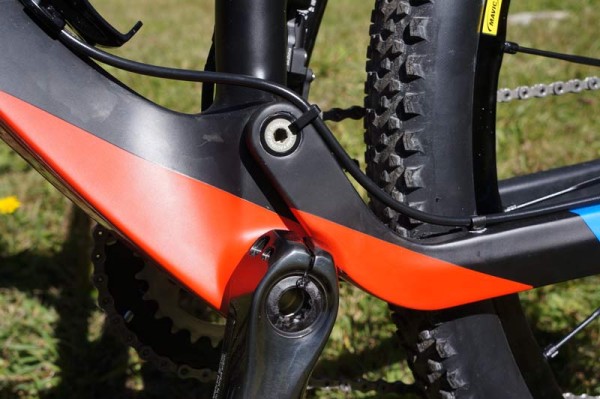
The main pivot point was tweaked on different frame sizes, moving it about 2mm lower for the 29ers, to tune the Anti Squat. This is to accommodate the different gear ratios typically used. For example, larger 29er wheels often see riders pushing a slightly larger rear cog for a given cadence.
The Anti Squat on the Oiz was tuned to preference easier gears, having more anti-squat when climbing, sometimes as much as 150%. Since a rider’s weight is putting more sag on the bike when climbing. This helps keep the bike higher in its travel for a more aggressive riding position overall, but particularly when climbing. Basically, the easier the gearing, the more anti squat the bike has, with a much more pronounced difference between large and small chainrings than between cassette cogs.
SPECS & BUILDS
The frame is designed to work with both mechanical and electronic drivetrains and lockouts. It’s even built to work with Shimano’s new Side Swing XTR front derailleur cable routing as well as standard direct mount front derailleurs.
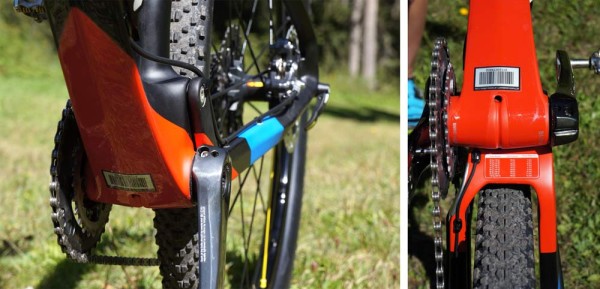
Other frame details include Pressfit BB92, tapered headtube, 31.6 seatpost and standard quick release rear axles. Yes, they stuck with QR rear, and here’s why: It’s lighter and quicker, both of which are of paramount importance for XC racers. The LTD, Team and M10 frames get the OMR carbon with your choice of Red/Black/Blue or Blue/White color schemes. The rest get OMP with either Black/White or a very attractive Gloss/Matte Black. Framesets will also be available. We’ll update with pricing as soon as we get it.
Oiz Di2 M-LTD – Full electronics all the way around, including the XTR 9000 Di2 shifting group plus Fox iCD electronic suspension lockout using a seatpost mounted battery. FSA headset and carbon seatpost/handlebar/stem, Mavic Crossmax SL wheels, Fox Factory suspension, Selle Italia SLR XC Gel Flow saddle and Maxxis Ikon tires complete the package.
Oiz M-TEAM – The Team model shares virtually all of the same spec save for a full XTR mechanical group with 2×11 26×36 with mechanical CTD remotes on the Fox Factory suspension.
Oiz M10 – The M10 drops down to a mix of SLX (front mech), XT (crankset, shifters, cassette) and XTR (rear mech), with Formula R1 brakes, DT Swiss Spline X-1700 wheels, FSA bar and stem, Race Face post, Selle Italia Flow XC saddle and Maxxis Ikon 2.2 tires.
Oiz M20 – The M20 is the top frame with their OMP carbon and gets a mostly SLX build with XT cranks and XTR rear derailleur. A full Race Face cockpit is used with the same wheels, tires and saddle as the M10.
Oiz M30 – This one drops down to full SLX with XT rear mech, but keeps virtually all the rest of the build from the M20.
Oiz M50 – The M50 gets a Deore/SLX mix, Formula C1 brakes, Mavic Cross One wheels, Race Face cockpit, Selle Royal Seta S1 saddle, lower level Maxxis Ikons and KMC chain.
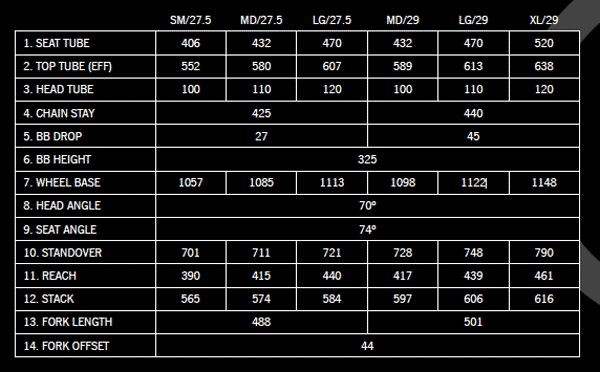
All models except the LTD get the Fox CTD mechanical lockout for both fork and shock, it’s just not shown here. They’ll be available in September.
